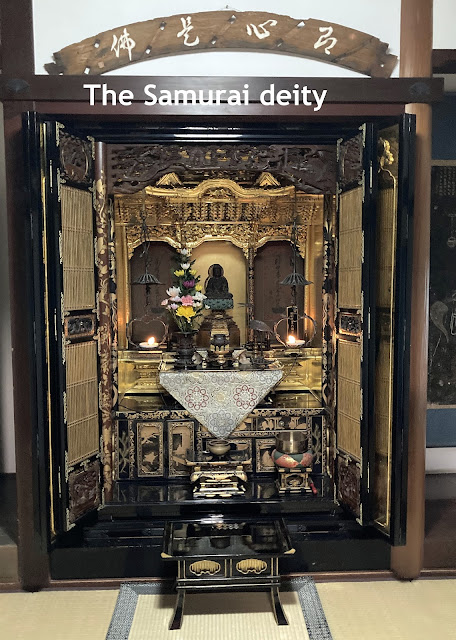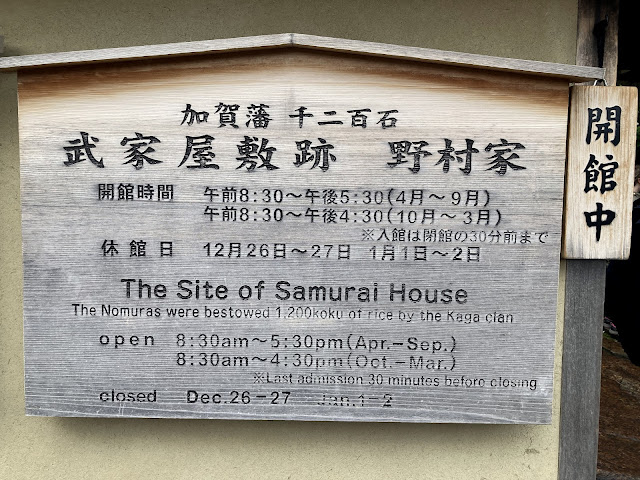Japan’s Samurai history is ancient and well documented. Hollywood has brought various films on these warriors and their moral code concerning samurai attitudes, behaviour and lifestyle termed as Bushido – “the way of the warrior”.
“Bushidō is a Japanese word that literally means "warrior way". It
is first attested in the 1616 work Kōyō Gunkan , a military chronicle recording the exploits of the Takeda
clan. The term is a compound of bushi ("warrior", literally 'military
+ man'), a Chinese-derived word first attested in
Japanese in 712 with the on'yomi (Sino-Japanese reading), and dō ('road, way'). In
modern usage, bushi is often used as a synonym for samurai; however, historical sources make it
clear that bushi and samurai were distinct concepts, with the former
referring to soldiers or warriors and the latter referring instead to a kind of
hereditary nobility.”
Nagamachi District of Kanazawa - “Kanazawa flourished in the Edo Period under the rule of the Maeda family and its population of over 100,000 made it one of the largest castle towns in feudal Japan. A city this large required an equally large administration, tasks given to mid and high ranking samurai to keep them busy during times of extended peace. The Nagamachi District is one of Kanazawa's best preserved samurai districts where many of these samurai had their homes. With no major fires or disasters during its long history, Nagamachi retains its time's quaint landscape. To maintain the state of the district as it always has been, the earthen walls surrounding the residences are covered with mats each winter to protect them from snow and frost damage”.
In 1551, one of the first westerners to Japan was the missionary Francis Xavier. The description of Francis shows that honour, weapons, and warfare were valued of utmost importance in Japanese culture… to quote:
“The Japanese are
very ambitious of honours and distinctions, and think themselves superior to
all nations in military glory and valour. They prize and honour all that has to
do with war, and all such things, and there is nothing of which they are so
proud as of weapons adorned with gold and silver. They always wear swords and
daggers both in and out of the house, and when they go to sleep, they hang them
at the bed's head. In short, they value arms more than any people I have ever
seen. They are excellent archers, and usually fight on foot, though there is no
lack of horses in the country. They are very polite to each other, but not to
foreigners, whom they utterly despise. They spend their means on arms, bodily
adornment, and on several attendants, and do not in the least care to save
money. They are, in short, a very warlike people, and engaged in continual wars
among themselves. They have all one sovereign, although for 150 years past, the
princes have ceased to obey him, and this is the cause of their perpetual feuds”.

As you enter the house, after removing footwear, you find a very serene atmosphere. Minimal furniture. Every room is large with large windows (in those days, I think they had different materials, not glass). There is a display of this Samurai costume shown. Then, you see a room with the Samurai deity. Further in are bedrooms with a grand view of the garden. It has a large pond, flowing water, lots of koi fish and perfectly stone and moss formations. It is so Zen that you could sit here for hours in total peace and meditate, if you wish.
I have attached photographs
of various Samurai armour… just look closely at the finishing with old and
silver work. The finery is amazing – the aim being to show one’s opponent as
well as the lower classes the power and strength one had against them.
Finally, a photograph
showing the different types of katanas (swords) which the samurai used. The foreigner
in the photo below is the manager of the showroom in Kyoto where we took the photos
of the four outfits shown after the garden pictures.
Japan is rightly
proud of their Samurai culture and their Bushido code. It went through its
phases of popularity depending upon the economic conditions. Tourists are
welcomed to attend Samurai sword fighting demonstration classes and to
appreciate the Japanese way of life in many other ways. Going off the beaten
path, into the interiors of Japan, with Google Translate as my companion, we
really saw parts of Japan which we would never have anticipated.

















No comments:
Post a Comment
Text and photographs are copyright of the author. No part of any article or photographs maybe transmitted or reproduced by any means, electronic, mechanical, photocopying or otherwise, without written permission. Do contact the author on email -- helpthesun@gmail.com